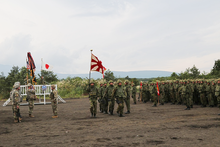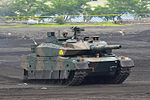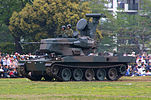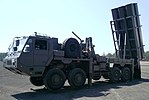| Japan Ground Self-Defense Force | |
|---|---|
| 陸上自衛隊 (Japanese) | |
 Emblem of the Japan Ground Self-Defense Force Emblem of the Japan Ground Self-Defense Force | |
| Founded | 1 July 1954; 70 years ago (1954-07-01) |
| Country | |
| Type | Army |
| Role | Land warfare |
| Size | 150,700 active personnel (2023) 56,000 reserve personnel (2023) |
| Part of | Japan Self-Defense Forces |
| Garrison/HQ | Ichigaya, Shinjuku, Tokyo, Japan |
| Colours | Red, White and Gold |
| March | "Battōtai" (抜刀隊) Play |
| Website | www |
| Commanders | |
| Prime Minister of Japan | Shigeru Ishiba |
| Minister of Defense | Gen Nakatani |
| Chief of Staff, Joint Staff | General Yoshihide Yoshida |
| Chief of the Ground Staff | General Yasunori Morishita |
| Insignia | |
| Flag |  |
The Japan Ground Self-Defense Force (Japanese: 陸上自衛隊, Hepburn: Rikujō Jieitai), JGSDF (陸自, Rikuji), also referred to as the Japanese Army, is the land warfare branch of the Japan Self-Defense Forces. Created on July 1, 1954, it is the largest of the three service branches.
New military guidelines, announced in December 2010, direct the Japan Self-Defense Forces away from their Cold War focus on the Soviet Union to a new focus on China, especially in respect of the dispute over the Senkaku Islands.
The JGSDF operates under the command of the chief of the ground staff, based in the city of Ichigaya, Shinjuku, Tokyo. The present chief of staff is General Yasunori Morishita. The JGSDF numbered 150,700 soldiers in 2023.
History
See also: Military history of Japan and Imperial Japanese Army20th century
Soon after the end of the Pacific War in 1945 with Japan accepting the Potsdam Declaration, the Imperial Japanese Army and Imperial Japanese Navy were dismantled by the orders of Supreme Commander for the Allied Powers (SCAP). Both were replaced by the United States Armed Forces occupation force, which assumed responsibility for the external defense of Japan.
Douglas MacArthur insisted that Japan have no military that could be used to settle international disputes or even for its own self defense. Accordingly, during the development of the Japan Constitution in 1946, Article 9 was added stating "the Japanese people forever renounce war as a sovereign right of the nation and the threat or use of force as means of settling international disputes." "In order to accomplish the aim of the preceding paragraph, land, sea, and air forces, as well as other war potential, will never be maintained. The right of belligerency of the state will not be recognized." It is believed that the Special Diet Session leader Hitoshi Ashida added the clause "In order to accomplish the aim of the preceding paragraph" in the middle of Article 9. The intent of this phrasing was to allow for the creation of military forces in Japan which would be for the defense of Japan, and not for settling international disputes. Then Prime Minister Shigeru Yoshida accepted this wording and was able to convince the US to allow Japan to operate "self defense" forces.
Under the terms of the Treaty of Mutual Cooperation and Security between the United States and Japan, United States forces stationed in Japan were to deal with external aggression against Japan while Japanese forces, both ground and maritime, would deal with internal threats and natural disasters. Only after the outbreak of the Korean War did MacArthur authorise Prime Minister Shigeru Yoshida to establish a 75,000 strong National Police Reserve. The next expansion came in 1952, when as a compromise in the face of U.S. calls to build up an army of 350,000, the National Police Reserve was re-titled the National Safety Force and expanded to 110,000.
In 1954, Prime Minister Yoshida impelled the Diet to accept the Defence Agency Establishment and the Self-Defence Force Laws, which explicitly authorized the forces to "defend Japan against direct and indirect aggression, and when necessary to maintain public order." On July 1, 1954, the National Security Board was reorganized as the Defense Agency, and the National Security Force was reorganized afterwards as the Japan Ground Self-Defense Force (Army), the Japan Maritime Self-Defense Force (Navy) and the Japan Air Self-Defense Force (Air Force), with General Keizō Hayashi appointed as the first Chairman of Joint Staff Council—professional head of the three branches. The enabling legislation for this was the 1954 Self-Defense Forces Act .
That year the actual strength of the Ground, Maritime and Air Self-Defence Forces reached 146,285, armed mainly with U.S. World War II vintage equipment. At least up until the 1970s, the Ground SDF was not built up to the point required to defeat an invasion attempt from the north – informed officials estimated that while ammunition provisions were officially said to be enough to last for two months, in actuality it would be used up in a week or less.
During the 1970s, the Japan Ground Self-Defense Force possessed a dubious ability to hold off a Soviet invasion of Hokkaido. Zbigniew Brzezinski observed in 1972 that it seemed optimized to fight "a Soviet invasion conducted on American patterns of a quarter of a century ago." Three years later in 1975, Osamu Kaihara, the former secretary of the National Defence Council, was reported in U.S. News & World Report that the SDF would have been totally ineffective in any Soviet attack, as the Ground SDF could only fight as an army for three to four days. While the force is now an efficient army of around 150,000, its apparent importance had, until recently, seemingly declined with the end of the Cold War, and attempts to reorient the forces as a whole to new post Cold War missions have been tangled in a series of internal political disputes.
21st century
On March 27, 2004, the Japan Defense Agency activated the Special Operations Group with the mandate under the JGSDF as its Counter-terrorist unit.
In 2015, the Japanese Diet passed a law that allowed for the reinterpretation of Article 9 of the constitution. JSDF personnel train with the American forces in amphibious assault units designed to take outlying islands.
Japan activated its first marine unit since World War II on April 7, 2018. The marines of the Amphibious Rapid Deployment Brigade are trained to counter invaders from occupying Japanese islands along the edge of the East China Sea.
British troops of the Honourable Artillery Company (HAC) exercised together for the first time with Japanese GSDF soldiers in Oyama, Shizuoka prefecture on 2 October 2018. The purpose was to improve their strategic partnership and security cooperation. Speaking about tensions regarding North Korea, Lieutenant General Patrick Sanders said that Japan "won't have to fight alone."
The JGSDF and the Indian Army conducted their first joint military exercise in the Indian state of Mizoram from 27 October to 18 November 2018. It primarily consisted of anti-terror drills and improving bilateral cooperation with 60 Japanese and Indian officers.
In March 2019, the Ministry of Defense established its first regional cyber protection unit in the Western Army of the Japan Ground Self-Defense Force (JGSDF) to safeguard defense communications from cyber attacks, such as for personnel deployed on remote islands with no established secure lines.
The Japanese government approved the first ever JSDF dispatch to a peacekeeping operation that is not led by the United Nations in 2019. JGSDF officers monitored the cease-fire between Israel and Egypt at the Multinational Force and Observers command in the Sinai peninsula from 19 April until 30 November 2019.
From September to the end of November 2021, the GSDF conducted nationwide drills with all units including 100,000 personnel, 20,000 vehicles, 120 aircraft and the JMSDF and JASDF as well as a U.S. Army landing ship. These were the largest GSDF exercises since after the Cold War in 1993. The exercises are based on 2019 National Defense Program Guidelines to strengthen defense capabilities. Minister of Defense Nobuo Kishi said it is to effectively respond to various situations.
Current deployment
Personnel


In 1989, basic training for lower-secondary and upper-secondary academy graduates began in the training brigade and lasted approximately three months. Specialized enlisted and non-commissioned officer (NCO) candidate courses were available in branch schools and qualified NCOs could enter an eight-to-twelve-week officer candidate program. Senior NCOs and graduates of an eighty-week NCO pilot course were eligible to enter officer candidate schools, as were graduates of the National Defense Academy at Yokosuka and graduates of all four-year universities. Advanced technical, flight, medical and command and staff officer courses were also run by the JGSDF. Like the maritime and air forces, the JGSDF ran a youth cadet program offering technical training to lower-secondary school graduates below military age in return for a promise of enlistment.
Because of population density and urbanization on the Japanese islands, only limited areas are available for large-scale training, and, even in these areas, noise restrictions are extensive. The JGSDF has adapted to these conditions by conducting command post exercises, map manoeuvres, investing in simulators and other training programs, as well as conducting live fire exercises overseas at locations such as the Yakima Training Center in the United States.
The JGSDF has two reserve components: the rapid-reaction reserve component (即応予備自衛官制度) and the main reserve component (一般予備自衛官制度). Members of the rapid-reaction component train 30 days a year. Members of the main reserve train five days a year. As of December 2007, there were 8,425 members of the rapid-reaction reserve component and 22,404 members of the main reserve component.
Equipment
Main article: List of modern equipment of the Japan Ground Self-Defense Force-
 Type 10 main battle tank
Type 10 main battle tank
-
 Type 90 main battle tank
Type 90 main battle tank
-
 Type 16 maneuver combat vehicle
Type 16 maneuver combat vehicle
-
 Type 87 self-propelled anti-aircraft gun
Type 87 self-propelled anti-aircraft gun
-
 Type 96 armored personnel carrier
Type 96 armored personnel carrier
-
 Type 89 infantry fighting vehicle
Type 89 infantry fighting vehicle
-
 Type 87 armoured recon and patrol vehicle
Type 87 armoured recon and patrol vehicle
-
JGSDF AH-64D & AH-1S
-
 Type 99 155 mm self-propelled howitzer
Type 99 155 mm self-propelled howitzer
-
 Type 12 surface-to-ship missile
Type 12 surface-to-ship missile
Organization
| Parts of this article (those related to documentation) need to be updated. Please help update this article to reflect recent events or newly available information. (April 2018) |
Major Command
 Ground Component Command (陸上総隊, Rikujō Sōtai) is headquartered in Nerima, Tokyo. It was reorganized from the Central Readiness Force on March 27, 2018. In wartime, it would take command of two to five armies.
Ground Component Command (陸上総隊, Rikujō Sōtai) is headquartered in Nerima, Tokyo. It was reorganized from the Central Readiness Force on March 27, 2018. In wartime, it would take command of two to five armies.
- Central Readiness Regiment, headquartered in Utsunomiya, Tochigi. The regiment is a rapid deployment force under the command of the GCC for deployment both in Japan and abroad.
Armies

 Northern Army, headquartered in Sapporo, Hokkaido
Northern Army, headquartered in Sapporo, Hokkaido North Eastern Army, headquartered in Sendai, Miyagi
North Eastern Army, headquartered in Sendai, Miyagi Eastern Army, headquartered in Asaka, Saitama
Eastern Army, headquartered in Asaka, Saitama Central Army, headquartered in Itami, Hyōgo
Central Army, headquartered in Itami, Hyōgo Western Army, headquartered at Kumamoto, Kumamoto
Western Army, headquartered at Kumamoto, Kumamoto
Division
JGSDF currently has 9 active duty divisions (1 armored, 8 infantry)
 1st Division, in Nerima.
1st Division, in Nerima. 2nd Division, in Asahikawa.
2nd Division, in Asahikawa. 3rd Division, in Itami.
3rd Division, in Itami. 4th Division, in Kasuga.
4th Division, in Kasuga. 6th Division, in Higashine.
6th Division, in Higashine. 7th Division (7th Armored Division), in Chitose.
7th Division (7th Armored Division), in Chitose. 8th Division, in Kumamoto.
8th Division, in Kumamoto. 9th Division, in Aomori.
9th Division, in Aomori. 10th Division, in Nagoya.
10th Division, in Nagoya.
Brigade
The JGSDF currently has eight combat brigades:
 1st Airborne Brigade, at Camp Narashino in Funabashi, Chiba Prefecture
1st Airborne Brigade, at Camp Narashino in Funabashi, Chiba Prefecture 5th Brigade, at Camp Obihiro in Obihiro, responsible for the defense of North Eastern Hokkaidō
5th Brigade, at Camp Obihiro in Obihiro, responsible for the defense of North Eastern Hokkaidō 11th Brigade, at Camp Makomanai in Sapporo, responsible for the defense of South Western Hokkaidō
11th Brigade, at Camp Makomanai in Sapporo, responsible for the defense of South Western Hokkaidō 12th Brigade (Air Assault), at Camp Soumagahara in Shintō, responsible for the defense of Gunma, Nagano, Niigata and Tochigi prefectures.
12th Brigade (Air Assault), at Camp Soumagahara in Shintō, responsible for the defense of Gunma, Nagano, Niigata and Tochigi prefectures. 13th Brigade, in Kaita, responsible for the defense of the Chūgoku region.
13th Brigade, in Kaita, responsible for the defense of the Chūgoku region. 14th Brigade, in Zentsūji, responsible for the defense of Shikoku.
14th Brigade, in Zentsūji, responsible for the defense of Shikoku. 15th Brigade, in Naha, responsible for the defense of Okinawa Prefecture
15th Brigade, in Naha, responsible for the defense of Okinawa Prefecture Amphibious Rapid Deployment Brigade, at Camp Ainoura in Sasebo, Nagasaki; amphibious force equipped to deploy from ships, where needed.
Amphibious Rapid Deployment Brigade, at Camp Ainoura in Sasebo, Nagasaki; amphibious force equipped to deploy from ships, where needed.
JGSDF divisions and brigades are combined arms units with infantry, armored, and artillery units, combat support units and logistical support units. They are regionally independent and permanent entities. The divisions' strength varies from 6,000 to 9,000 personnel. The brigades are smaller with 3,000 to 4,000 personnel.
The JGSDF currently has nine combat support brigades:
- 1st Artillery Brigade, at Camp Kita Chitose in Chitose, Hokkaido Prefecture
- 2nd Artillery Brigade , at camp Yufuin in Yufu, Ōita Prefecture
- 1st Helicopter Brigade, at Camp Kisarazu in Kisarazu, Chiba Prefecture
- 1st Anti-Aircraft Artillery Brigade, at Camp Higashi in Chitose, Hokkaido Prefecture
- 2nd Anti-Aircraft Artillery Brigade, at Camp Iizuka in Iizuka, Fukuoka Prefecture
- 1st Engineer Brigade, at Camp Koga in Koga, Ibaraki Prefecture
- 2nd Engineer Brigade, at Camp Funaoka in Shibata, Miyagi Prefecture
- 3rd Engineer Brigade, at Camp Eniwa in Eniwa, Hokkaidō Prefecture
- 4th Engineer Brigade, at Camp Okubo in Uji, Kyoto Prefecture
- 5th Engineer Brigade, at Camp Ogōri in Ogōri, Fukuoka Prefecture
Other units
- Other Units and Organizations
- Material Control Command
- Signal Brigade
- Military Police
- Military Intelligence Command
- Ground Officer Candidate School
- Special Forces Group
- Training-Evaluation, Education, Research & Development Command (created in 2018 by integrating the former Ground Research & Development Command and JGSDF Staff College)


Ranks
Main article: Ranks and insignia of the Japan Self-Defense ForcesCommissioned officer ranks
The rank insignia of commissioned officers.
| Rank group | General / flag officers | Senior officers | Junior officers | |||||||||||||||||||||
|---|---|---|---|---|---|---|---|---|---|---|---|---|---|---|---|---|---|---|---|---|---|---|---|---|

|

|

|

|

|

|

|

|

|

| |||||||||||||||
| 幕僚長たる陸将 Bakuryōchō-taru-rikushō |
陸将 Rikushō |
陸将補 Rikushō-ho |
1等陸佐 Ittō rikusa |
2等陸佐 Nitō rikusa |
3等陸佐 Santō rikusa |
1等陸尉 Ittō rikui |
2等陸尉 Nitō rikui |
3等陸尉 Santō rikui |
准陸尉 Jun rikui | |||||||||||||||
Other ranks
The rank insignia of non-commissioned officers and enlisted personnel.
| Rank group | Senior NCOs | Junior NCOs | Enlisted | |||||||||||||||||||||||||||||||||
|---|---|---|---|---|---|---|---|---|---|---|---|---|---|---|---|---|---|---|---|---|---|---|---|---|---|---|---|---|---|---|---|---|---|---|---|---|

|

|

|

|

|

|

|

| |||||||||||||||||||||||||||||
| 陸曹長 Rikusōchō |
1等陸曹 Ittō rikusō |
2等陸曹 Nitō rikusō |
3等陸曹 Santō rikusō |
陸士長 Rikushichō |
1等陸士 Ittō rikushi |
2等陸士 Nitō rikushi |
自衛官候補生 Jieikan kōhosei | |||||||||||||||||||||||||||||
Culture and traditions
Music and traditions
The Japan Ground Self-Defense Force dropped nearly all traditions associated with the former Imperial Japanese Army save for the march music tradition (Review March was the official march of the IJA and today's JGSDF). However the tradition of bugle call playing, a tradition left by the Imperial Army, has remained till the present. Each JGDSF formation has had a bugle platoon or company led by a Bugle Major.
Flag and insignia
The Imperial Japanese Army flag with symmetrical 16 rays and a 2:3 ratio was abolished in 1945. The Japan Self-Defense Forces (JSDF) and Japan Ground Self-Defense Force (JGSDF) use a significantly different variation of the Rising Sun Flag with red, white and gold colors. It has 8-rays and an 8:9 ratio. The edges of the rays are asymmetrical since they form angles at 19, 21, 26 and 24 degrees. It also has indentations for the yellow (golden) irregular triangles along the borders. The JSDF Rising Sun Flag was adopted by a law/order/decree published in the Official Gazette of June 30, 1954.
References
- ^ "Japan Self-Defense Force | Defending Japan". Defendingjapan.wordpress.com. Archived from the original on 2015-02-16. Retrieved 2014-08-03.
- ^ International Institute for Strategic Studies (15 February 2023). The Military Balance 2023. London: Routledge. p. 258. ISBN 978-1-000-91070-4.
- "How to Secure Japan? Put Premium on JSDF Personnel More Than Hardware". JAPAN Forward. 5 March 2019.
- Fackler, Martin (16 December 2010). "Japan Announces Defense Policy to Counter China". The New York Times. Archived from the original on 4 November 2016. Retrieved 17 December 2010.
- Frank Kowalski, An Inoffensive Rearmament: The Making of the Postwar Japanese Army Archived 2016-01-13 at the Wayback Machine, Naval Institute Press, 2014, p.72
- Raymond L. Brown, 'Japan's Army and the Modern Japanese Military System,' RUSI Journal, December 1978, p.34
- Boei nenkan (Tokyo, 1955), pp.227-247 quoted in Weinstein chapter in James H. Buck (ed.), The Modern Japanese Military System, Sage Publications, Beverly Hills/London, 1975, p.45
- Weinstein chapter in James H. Buck (ed.), The Modern Japanese Military System, Sage Publications, Beverly Hills/London, 1975, p.47
- Zbigniew Brzezinski, The Fragile Blossom (Harper, 1972) p.95, in James H. Buck, 'The Japanese Military in the 1980s, in James H. Buck (ed.), The Modern Japanese Military System, Sage Publications, Beverly Hills/London, 1975, p.220
- U.S. News & World Report, March 24, 1975, p.34, in James H. Buck, 'The Japanese Military in the 1980s,' in James H. Buck (ed.), The Modern Japanese Military System, Sage Publications, Beverly Hills/London, 1975, p.220
- IISS 2010, pp. 408–411
- "日本国の精鋭部隊&特殊部隊 (Japan's elite and special forces)". Archived from the original on October 29, 2004. Retrieved March 31, 2020.
- "An article in The Economist dated Nov 20, 2017". The Economist. November 20, 2017. Archived from the original on November 21, 2017. Retrieved November 21, 2017.
- Kubo, Nobuhiro Japan activates first marines since WW2 to bolster defenses against China Archived 2018-08-02 at the Wayback Machine. April 7, 2018. Reuters. Retrieved August 2, 2018
- "British troops join forces with Japanese for first time on their soil amid North Korea tensions". The Telegraph. 2 October 2018. Archived from the original on 2018-10-12. Retrieved 18 October 2018.
- "India-Japan military exercise begins in Mizoram". Moneycontrol.com. 1 November 2018. Archived from the original on 2018-11-02. Retrieved 6 November 2018.
- "Japan to create first regional counter-cyberattack unit in GSDF's Western Army". The Mainichi. 20 August 2018. Retrieved 26 August 2018.
- "Japan approves plan to send JSDF officers to Sinai, on first non-U.N. peacekeeping mission". The Mainichi. 2 April 2019. Archived from the original on 2 April 2019. Retrieved 3 April 2019.
- ^ "Japan's GSDF begins nationwide drills for first time since Cold War". The Japan Times. October 16, 2021. Archived from the original on September 17, 2021.
- Archived March 9, 2010, at the Wayback Machine
- https://www.mod.go.jp/gsdf/tercom/en/index.html
- ^ "自衛官の階級" [Self-Defense Forces rank]. mod.go.jp (in Japanese). Japanese Ministry of Defense. Retrieved 7 June 2021.
- "自衛隊法施行令" [Self-Defense Forces Law Enforcement Order] (in Japanese). Government of Japan. June 3, 1954. Retrieved January 25, 2008.
- ^ Phil Nelson; various. "Japanese military flags". Flags of the World. Flagspot.
External links
- Official website

- Number of Tanks and Major Artillery and Performance Specifications
- Number of Major Aircraft and Performance Specifications
- Guided Missile Specifications
| Leadership | |
|---|---|
| Personnel | |